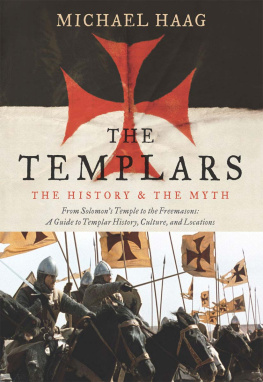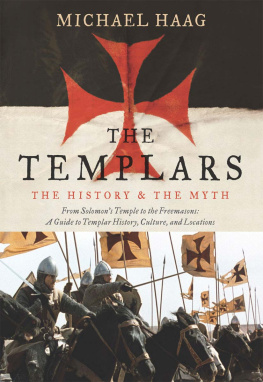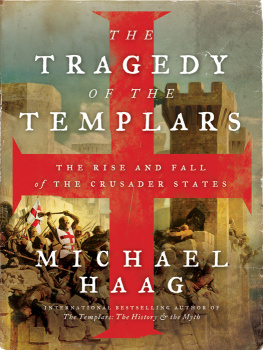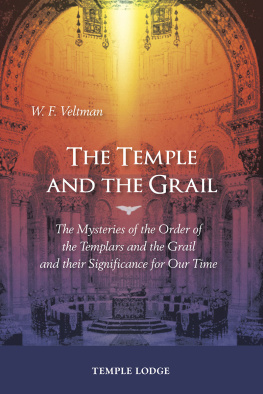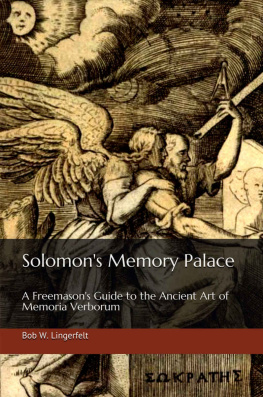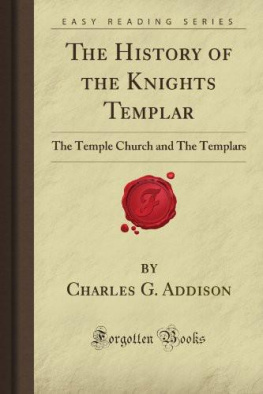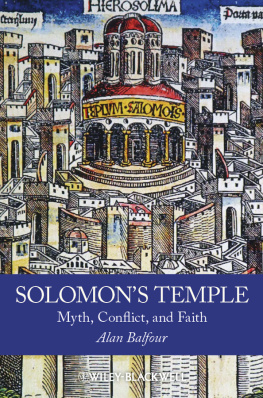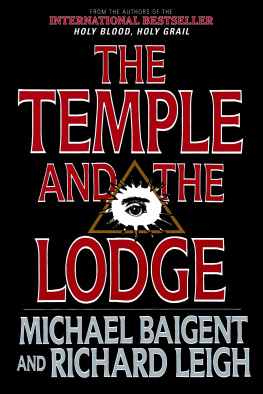Michael Haag - The Templars: The History and the Myth: From Solomons Temple to the Freemasons
Here you can read online Michael Haag - The Templars: The History and the Myth: From Solomons Temple to the Freemasons full text of the book (entire story) in english for free. Download pdf and epub, get meaning, cover and reviews about this ebook. year: 2009, publisher: HarperCollins, genre: History. Description of the work, (preface) as well as reviews are available. Best literature library LitArk.com created for fans of good reading and offers a wide selection of genres:
Romance novel
Science fiction
Adventure
Detective
Science
History
Home and family
Prose
Art
Politics
Computer
Non-fiction
Religion
Business
Children
Humor
Choose a favorite category and find really read worthwhile books. Enjoy immersion in the world of imagination, feel the emotions of the characters or learn something new for yourself, make an fascinating discovery.
- Book:The Templars: The History and the Myth: From Solomons Temple to the Freemasons
- Author:
- Publisher:HarperCollins
- Genre:
- Year:2009
- Rating:3 / 5
- Favourites:Add to favourites
- Your mark:
- 60
- 1
- 2
- 3
- 4
- 5
The Templars: The History and the Myth: From Solomons Temple to the Freemasons: summary, description and annotation
We offer to read an annotation, description, summary or preface (depends on what the author of the book "The Templars: The History and the Myth: From Solomons Temple to the Freemasons" wrote himself). If you haven't found the necessary information about the book — write in the comments, we will try to find it.
The Templars: The History and the Myth: From Solomons Temple to the Freemasons — read online for free the complete book (whole text) full work
Below is the text of the book, divided by pages. System saving the place of the last page read, allows you to conveniently read the book "The Templars: The History and the Myth: From Solomons Temple to the Freemasons" online for free, without having to search again every time where you left off. Put a bookmark, and you can go to the page where you finished reading at any time.
Font size:
Interval:
Bookmark:
The History and the Myth

To Jon Buller and Susan Schade
les chtelains de Mont Becket
The Templars were founded in Jerusalem on Christmas Day 1119 at the Church of the Holy Sepulchre, on the spot which marks the crucifixion, burial and resurrection of Jesus Christ. A religious order of fighting knights, their headquarters was on the Temple Mount, that vast platform rising above the city where King Solomon had built his Temple two thousand years before. Surrounded by these potent historical and sacred associations, the Templars assumed their responsibility to protect pilgrims visiting the holy shrines and to defend the Holy Land.
The Templars soon became a formidable international organisation. Vast donations of properties were made in Europe to maintain this elite taskforce overseas, and special rights and privileges were granted by popes and kings. Dressed in their white tunics emblazoned with a red cross, they became the Wests first uniformed standing army and also pioneered an extensive financial network that reached from London and Paris to the Euphrates and the Nile. As an order they became powerful and wealthy, but as individuals their existence was simple and austere. Their bravery was legendary, their dedication was absolute and their attrition rate was high; at least twenty thousand Templars were killed, either on the battlefield or after being taken captive and refusing to renounce their faith to save their lives.
Yet in the end the Templars were destroyed not by the Muslims in the East but by their fellow Christians in the West. On Friday 13 October 1307 the Templars were arrested throughout France and soon elsewhere throughout Europe. They were charged with heinous heresies, obscenities, homosexual practises and idol worship; many were tortured and confessed. The end came in 1314 when the Templars last Grand Master was burnt alive at the stake.
The shock and mystery of their downfall has excited interest in the Templars for seven centuries since. Some historians have conjectured that the Templars sojourn in the East brought them into contact with Gnosticism, the ancient heresy embraced by the Cathars of France, while the Freemasons have drawn a line of occult knowledge transmitted from the Temple of Solomon via the Templars to themselves.
Never has speculation about the Templars been more feverish than today. Did the Templars carry out excavations beneath the Temple Mount and find something extraordinary that explains their rise to power and wealth and, according to some, their continued but clandestine existence to this day? Was it some vast treasure? Or the Ark of the Covenant? The Holy Grail? The secret to the life of Christ and his message? And where did this secret travel when the Templars were suppressed? To Scotland, to America?
What is certainly true is that the rise and fall of the Templars exactly corresponded to the two centuries of the crusading venture in the East, where after a series of outrages against Western pilgrims and Eastern Christians, and in the face of renewed aggression which threatened all of Europe, the First Crusade was launched in 1095 to recover Asia Minor, Syria and Palestine from Muslim occupation. Simultaneously, the struggle was being fought in the Iberian peninsula where the Templars eventually helped liberate Spain and Portugal. But the crusading effort in the East, with the Templars at its heart, was never enough to withstand the overwhelming Muslim forces that could be brought into the field when they were united by the likes of Saladin or the Mamelukes. In 1291 when the Mamelukes drove the last Frankish settlers out of the Holy Land, the Templars lost the main purpose of their existence, and soon they fell victim to the rapacious greed and tyrannical ambitions of the King of France.
One of the great Templar mysteries has always been the role played by the Papacy in the downfall of the order. The Pope was meant to be their protector and to the Pope alone the Templars owed obedience, yet to judge from the apparently supine acquiescence of the Papacy to the demands of the King of France, the Pope either betrayed the Templars or believed them guilty of terrible crimes. These conjectures took a dramatic turn in 2007, when the Vatican published a facsimile edition of a parchment recording the Templar leaders testimony to Papal investigators at Chinon in 1308. This document had been discovered in the Vatican Secret Archives and revealedseven hundred years too late to save the lives of James of Molay and countless other knightsthat the Pope believed the Templars innocent of heresy.
About this book
There are seven parts to this book. The first four cover the historical narrative. They begin with the origins of Solomons Temple in Jerusalemfrom which the Templars took their name. And they continue with the rise of Christianity and the challenge of Islamthe context for pilgrimages and the Crusades which became the raison dtre for the Templars. The narrative then proceeds through the foundation of the Templars, their rise to power and their dramatic fall as the Holy Land was lost to the Muslims, and it concludes with their trial. Part Five deals with the aftermath of the Templars dissolution, their various survivals, and their co-optation by Freemasons and conspiracy theorists.
The books last two parts include guides to the most interesting Templar sites and buildings to be seen today in the Middle East and Europe, and to the emergence of Templarismthe adoption of Templar history and myth in popular culture, from fiction to computer games, as well as reviews of the best Templar books and websites.
Three Temples and a Vision
The story of the Templars must begin with that of the Temple Mount in Jerusalem, where the Dome of the Rock stands today. For it was here that Solomons Temple was builtthe legendary, lost temple of the Jews, from which the Templars, as guardians of the Holy Land, took their name, and on whose site they created their military and spiritual headquarters. Sacred to Judaism, Christianity and Islam, no world site has greater resonance; nor, as home of the Ark of the Covenant, such enduring myth.
Physically, the Temple Mount takes the form of a vast platform, which was constructed over a natural hill by Herod the Great to support his gigantic templebuilt around 2510 BC on the site of Solomons original temple of a thousand years earlier. It is Herods Temple that is referred to in the Gospel of Mark 13:12 , when a disciple says to Jesus, Master, see what manner of stones and what buildings are here!, to which Jesus replies, Seest thou these great buildings? There shall not be left one stone upon another, that shall not be thrown down. And it was this temple that, duly bearing out the prophecy, was destroyed by the Roman emperor Titus in AD 70 in the course of putting down a Jewish rebellion.
Though nothing survives of Herods Temple, the exposed western retaining wall of the Temple Mount platform, famously known as the Wailing Wall, has come to symbolise not only the lost Temple of Herod but the first temple built on this same spot three thousand years ago, the Temple of Solomon.
Solomon, the son of David and Bathsheba, became King of Israel in about 962 BC and died in about 922 BC. During the forty years of his reign, he expanded trade and political contacts, centralised the authority of the crown against tribal fragmentation, and engaged in an elaborate building programme. His principal building works were the royal palace and the Temple in Jerusalem.
Font size:
Interval:
Bookmark:
Similar books «The Templars: The History and the Myth: From Solomons Temple to the Freemasons»
Look at similar books to The Templars: The History and the Myth: From Solomons Temple to the Freemasons. We have selected literature similar in name and meaning in the hope of providing readers with more options to find new, interesting, not yet read works.
Discussion, reviews of the book The Templars: The History and the Myth: From Solomons Temple to the Freemasons and just readers' own opinions. Leave your comments, write what you think about the work, its meaning or the main characters. Specify what exactly you liked and what you didn't like, and why you think so.

